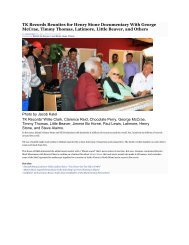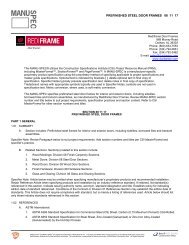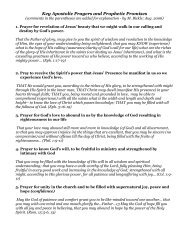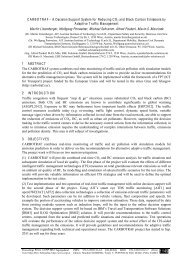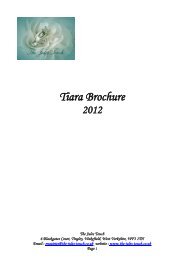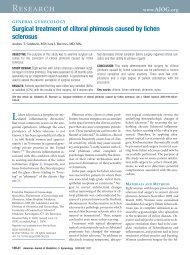Efficacy of 904 nm Gallium Arsenide Low Level Laser Therapy in the ...
Efficacy of 904 nm Gallium Arsenide Low Level Laser Therapy in the ...
Efficacy of 904 nm Gallium Arsenide Low Level Laser Therapy in the ...
Create successful ePaper yourself
Turn your PDF publications into a flip-book with our unique Google optimized e-Paper software.
Effects <strong>of</strong> <strong>904</strong>‐Nm <strong>Low</strong>‐<strong>Level</strong> <strong>Laser</strong> <strong>Therapy</strong> <strong>in</strong> <strong>the</strong> Management <strong>of</strong> Lateral<br />
Epicondylitis: A Randomized Controlled Trial.<br />
Lam LK, Che<strong>in</strong>g GL., Physio<strong>the</strong>rapy Department, Queen Elizabeth Hospital, Hong Kong.<br />
Objective: The aim <strong>of</strong> this study was to evaluate <strong>the</strong> effectiveness <strong>of</strong> <strong>904</strong>‐<strong>nm</strong> low‐level laser <strong>the</strong>rapy (LLLT) <strong>in</strong> <strong>the</strong><br />
management <strong>of</strong> lateral epicondylitis.<br />
Background Data: Lateral epicondylitis is characterized by pa<strong>in</strong> and tenderness over <strong>the</strong> lateral elbow, which may also<br />
result <strong>in</strong> reduction <strong>in</strong> grip strength and impairment <strong>in</strong> physical function. LLLT has been shown effective <strong>in</strong> its <strong>the</strong>rapeutic<br />
effects <strong>in</strong> tissue heal<strong>in</strong>g and pa<strong>in</strong> control.<br />
Methods: Thirty‐n<strong>in</strong>e patients with lateral epicondylitis were randomly assigned to receive ei<strong>the</strong>r active laser with an<br />
energy dose <strong>of</strong> 0.275 J per tender po<strong>in</strong>t (laser group) or sham irradiation (placebo group) for a total <strong>of</strong> n<strong>in</strong>e sessions. The<br />
outcome measures were mechanical pa<strong>in</strong> threshold, maximum grip strength, level <strong>of</strong> pa<strong>in</strong> at maximum grip strength as<br />
measured by <strong>the</strong> Visual Analogue Scale (VAS) and <strong>the</strong> subjective rat<strong>in</strong>g <strong>of</strong> physical function with Disabilities <strong>of</strong> <strong>the</strong> Arm,<br />
Shoulder and Hand (DASH) questionnaire.<br />
Results: Significantly greater improvements were shown <strong>in</strong> all outcome measures with <strong>the</strong> laser group than with <strong>the</strong><br />
placebo group (p < 0.0125), except <strong>in</strong> <strong>the</strong> two subsections <strong>of</strong> DASH.<br />
Conclusion: This study revealed that LLLT <strong>in</strong> addition to exercise is effective <strong>in</strong> reliev<strong>in</strong>g pa<strong>in</strong>, and <strong>in</strong> improv<strong>in</strong>g <strong>the</strong> grip<br />
strength and subjective rat<strong>in</strong>g <strong>of</strong> physical function <strong>of</strong> patients with lateral epicondylitis.<br />
Acute Cervical Pa<strong>in</strong> is Relieved with <strong>Gallium</strong> <strong>Arsenide</strong> (GaAs) <strong>Laser</strong><br />
radiation: A Double Bl<strong>in</strong>d Prelim<strong>in</strong>ary Study<br />
Fernando A Soriano, Roxana Rios, Miguel Pedrola, Jaquelel<strong>in</strong>a Giagnorio and Carlos R Battagliotti 1<br />
1<br />
The Second Ca<strong>the</strong>dra <strong>of</strong> Internal and Therapeutic Medic<strong>in</strong>e, Teach<strong>in</strong>g Hospital Eva Peron, National University <strong>of</strong> Rosario School <strong>of</strong> Medic<strong>in</strong>e, Rosario,<br />
Argent<strong>in</strong>a<br />
Study Design/Patients and Methods: Seventy‐one patients with acute cervical pa<strong>in</strong> were randomized <strong>in</strong> two groups.<br />
Group A, 37 patients were irradiated with a pulsed GaAs diode laser, <strong>904</strong> <strong>nm</strong>, pulse width 200 nsec, pulse frequency<br />
10,000 Hz, peak power <strong>of</strong> 20 W, average power 40 mW, spot size 150 um 2 <strong>in</strong> area (<strong>in</strong>cident power density <strong>of</strong><br />
approximately 26 W/cm 2 ) and an angle <strong>of</strong> divergence <strong>of</strong> 6 o . The laser was applied <strong>in</strong> <strong>the</strong> po<strong>in</strong>t technique with a dose <strong>of</strong> 4<br />
J/cm 2 per po<strong>in</strong>t <strong>in</strong> <strong>the</strong> area <strong>of</strong> pa<strong>in</strong>. Group B, 34 patients, was treated with sham irradiation with a deactivated laser<br />
system. Nei<strong>the</strong>r <strong>the</strong> patients nor <strong>the</strong> operator knew which group each patient was randomly assigned to. The use <strong>of</strong><br />
analgesic drugs and physical <strong>the</strong>rapy was excluded <strong>in</strong> both groups. Pa<strong>in</strong> was evaluated through a l<strong>in</strong>ear colour scale.<br />
<strong>Laser</strong> treatment was considered effective when pa<strong>in</strong> relief was more than 60%.<br />
Results: The treatment was effective <strong>in</strong> 94.59% <strong>of</strong> patients <strong>in</strong> group A and 38.24% <strong>of</strong> group B (p < 0.0019). The pa<strong>in</strong> was<br />
relieved completely <strong>in</strong> 67.56% <strong>of</strong> patients <strong>in</strong> group A and <strong>in</strong> 17.65% <strong>in</strong> group B. In patients <strong>in</strong> whom <strong>the</strong> response to <strong>the</strong><br />
treatment was effective, <strong>the</strong> pa<strong>in</strong> returned <strong>in</strong> <strong>the</strong> six months follow<strong>in</strong>g treatment <strong>in</strong> 14.28% <strong>of</strong> Group A, but <strong>in</strong> 58.33% <strong>of</strong><br />
group B (p < 0.005). No side effects were observed.<br />
Conclusion: These results suggest that GaAs laser radiation is an efficient and safe treatment for patients with acute<br />
cervical pa<strong>in</strong>. Six years have passed s<strong>in</strong>ce we <strong>in</strong>corporated <strong>the</strong> GaAs laser <strong>in</strong>to our <strong>the</strong>rapeutic arsenal and up to date we<br />
have irradiated more than two thousand patients with different k<strong>in</strong>ds <strong>of</strong> pa<strong>in</strong> and pa<strong>in</strong> sites. The aim <strong>of</strong> this work is to<br />
evaluate <strong>the</strong> real <strong>the</strong>rapeutic effect versus <strong>the</strong> placebo effect <strong>of</strong> laser <strong>the</strong>rapy <strong>in</strong> patients with acute cervical pa<strong>in</strong> <strong>in</strong> both<br />
<strong>the</strong> immediate effect and <strong>the</strong> possible latency <strong>of</strong> <strong>the</strong> pa<strong>in</strong> relief with LLLT.





